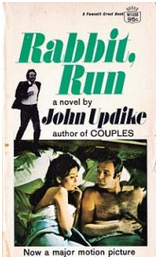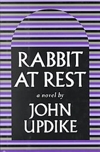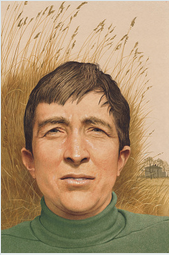“‘[Henry Bech’s] marriage was like the Zionist state they were in: a mistake long deferred, a miscarriage of passé fervor and antiquated tribal righteousness, an attempt to be safe on an earth where there was no safety,’ Updike writes, sizing up Israel better than Bellow ever did through the eyes of a Jew who is accustomed to living in a permanent state of alienation. Reviewing the first Bech volume in Commentary in 1970, Cynthia Ozick accused Updike of dreaming up a false and essentially parodic Jew—but this Jew, for one, found Bech welcome and familiar company.”
 So wrote David Klion, who is working on a book about the legacy of neoconservatism and is a columnist for The Nation, a contributing editor at Jewish Currents, and a “writer for many lefty mags.” His review/reading recommendation on The Complete Henry Bech appeared in the Sept. 5, 2025 issue of Jewish Currents under the heading, “Shabbat Reading List.” For those planning on attending the Roth-Updike Conference in New York City October 19-22—a joint conference of the Philip Roth and John Updike Societies—the timing couldn’t be more perfect.
So wrote David Klion, who is working on a book about the legacy of neoconservatism and is a columnist for The Nation, a contributing editor at Jewish Currents, and a “writer for many lefty mags.” His review/reading recommendation on The Complete Henry Bech appeared in the Sept. 5, 2025 issue of Jewish Currents under the heading, “Shabbat Reading List.” For those planning on attending the Roth-Updike Conference in New York City October 19-22—a joint conference of the Philip Roth and John Updike Societies—the timing couldn’t be more perfect.
“If the Bech stories were merely affectionate sendups of Roth or experiments in whether a goy can channel a Jew persuasively in fiction,” Klion wrote, “they might just be amusing—and for my purposes, dayeinu. But I became fully invested in Bech as a cranky, horny, self-absorbed, self-effacing, skeptical, and occasionally wise antihero, rendered through Updike’s always lyrical prose. Taken together, the stories constitute an extended comic meditation on bookish fame (or semi-fame), inspiration (or lack thereof), and frustration, complete with a fake bibliography and fake reviews from the likes of Alfred Kazin and Ellen Willis.”

 John Updike Society president James Plath spent two weeks as a fall 2023 Quarry Farm Fellow working on an essay detailing how Twain modeled being a celebrity writer for both Hemingway and Updike. Plath conducted that research, but also felt compelled to write poems about the house and its inhabitants. Not surprisingly, Updike found his way into one of the poems:
John Updike Society president James Plath spent two weeks as a fall 2023 Quarry Farm Fellow working on an essay detailing how Twain modeled being a celebrity writer for both Hemingway and Updike. Plath conducted that research, but also felt compelled to write poems about the house and its inhabitants. Not surprisingly, Updike found his way into one of the poems: Sometimes the most interesting takes on an author come from great thinkers outside the field of literature. Such is the case with an article by Kali DuBois that was published in Medium:
Sometimes the most interesting takes on an author come from great thinkers outside the field of literature. Such is the case with an article by Kali DuBois that was published in Medium:  “His Rabbit quartet of novels . . . is among the peerless accomplishments of 20th century fiction in its chronicle of living through the confusion of the Viet Nam war, feminism, civil rights and the sexual revolution in the person of the series’ titular character, Rabbit Angstrom. Not deep of thought but rich in resentment, Angstrom was an analog of American culture itself, a congested vein of self-seeking that never recovered from the raw sensation of youthful vigor; Angstrom, like the country itself, resentfully fumbled about for years ruing the loss of vitality and trying to replace it with new things, the crabby possessiveness of the middle class.”
“His Rabbit quartet of novels . . . is among the peerless accomplishments of 20th century fiction in its chronicle of living through the confusion of the Viet Nam war, feminism, civil rights and the sexual revolution in the person of the series’ titular character, Rabbit Angstrom. Not deep of thought but rich in resentment, Angstrom was an analog of American culture itself, a congested vein of self-seeking that never recovered from the raw sensation of youthful vigor; Angstrom, like the country itself, resentfully fumbled about for years ruing the loss of vitality and trying to replace it with new things, the crabby possessiveness of the middle class.” Heer had written, “Not too long ago, the Fourth of July was a festive occasion: a day of national celebration, hot dogs and parades, flag-waving and fireworks. John Updike memorialized the traditional July 4 holiday in Rabbit at Rest (1990), the
Heer had written, “Not too long ago, the Fourth of July was a festive occasion: a day of national celebration, hot dogs and parades, flag-waving and fireworks. John Updike memorialized the traditional July 4 holiday in Rabbit at Rest (1990), the 
 “American novelist John Updike claimed not to write for ego: ‘I think of it more as innocence. A writer must be in some way innocent.’ We might raise an eyebrow at this, from the highly successful and famously intrusive chronicler of human closeness. Even David Foster Wallace, the totem effigy of literary chauvinism, denounced Updike as a ‘phallocrat.’ But if we doubt such innocence of Updike, pronouncing as he was at the flushest height of fiction’s postwar heyday, we might believe it of these new novelists, writing as they are and when they are. Without a promise of glory, and facing general skepticism, they have written from pure motives. They are novelists as Updike defined them: ‘only a reader who was so excited that he tried to imitate and give back the bliss that he enjoyed’.
“American novelist John Updike claimed not to write for ego: ‘I think of it more as innocence. A writer must be in some way innocent.’ We might raise an eyebrow at this, from the highly successful and famously intrusive chronicler of human closeness. Even David Foster Wallace, the totem effigy of literary chauvinism, denounced Updike as a ‘phallocrat.’ But if we doubt such innocence of Updike, pronouncing as he was at the flushest height of fiction’s postwar heyday, we might believe it of these new novelists, writing as they are and when they are. Without a promise of glory, and facing general skepticism, they have written from pure motives. They are novelists as Updike defined them: ‘only a reader who was so excited that he tried to imitate and give back the bliss that he enjoyed’.
